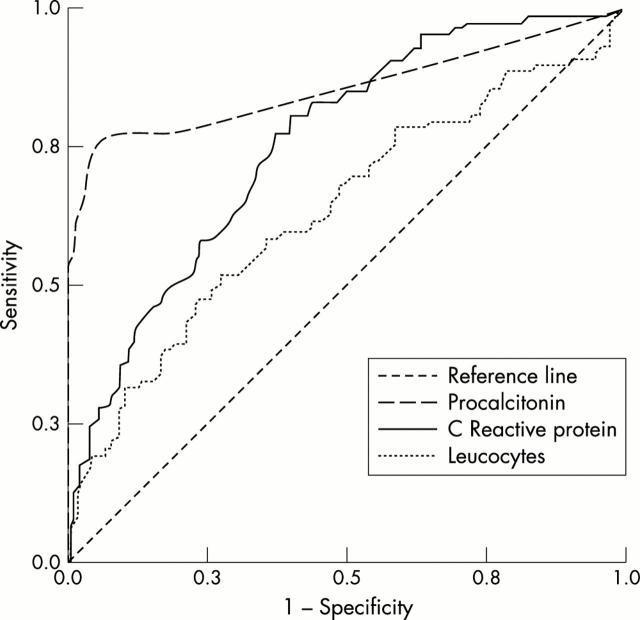Abstract
Objective: To study the levels of procalcitonin (PCT) in various inflammatory states seen in an internal medicine department and to evaluate the possible discriminative role of PCT in differentiating bacterial infection from other inflammatory processes.
Methods: PCT, C reactive protein (CRP), and white blood cell count (WBC) were measured in patients admitted to the department for fever or biological inflammatory syndrome, or both. The serum of 173 consecutive patients was analysed according to the aetiological diagnosis. The patients were divided into two groups: group I (n=60) with documented bacterial or fungal infection; group II (n=113) with abacterial inflammatory disease.
Results: PCT levels were >0.5 ng/ml in 39/60 (65%) patients in group I. In group II, three patients with a viral infection had slightly increased PCT levels (0.7, 0.8, and 1.1 ng/ml) as did two others, one with crystal arthritis and the other with vasculitis (0.7 ng/ml in both cases). All other patients in group II had PCT levels <0.5 ng/ml. In this study a value of PCT >0.5 ng/ml was taken as the marker of bacterial infection (sensitivity 65%, specificity 96%). PCT values were more discriminative than WBC and CRP in distinguishing a bacterial infection from another inflammatory process.
Conclusion: PCT levels only rose significantly during bacterial infections. In this study PCT levels >1.2 ng/ml were always evidence of bacterial infection and the cue for starting antibiotic treatment.
Full Text
The Full Text of this article is available as a PDF (127.8 KB).
Figure 1 .
Prediction of bacterial infection ROC curves, with area under curve for procalcitonin=0.84, WBC=0.618, CRP=0.729.
Selected References
These references are in PubMed. This may not be the complete list of references from this article.
- Assicot M., Gendrel D., Carsin H., Raymond J., Guilbaud J., Bohuon C. High serum procalcitonin concentrations in patients with sepsis and infection. Lancet. 1993 Feb 27;341(8844):515–518. doi: 10.1016/0140-6736(93)90277-N. [DOI] [PMC free article] [PubMed] [Google Scholar]
- Bernard L., Ferrière F., Casassus P., Malas F., Lévêque S., Guillevin L., Lortholary O. Procalcitonin as an early marker of bacterial infection in severely neutropenic febrile adults. Clin Infect Dis. 1998 Oct;27(4):914–915. doi: 10.1086/517175. [DOI] [PubMed] [Google Scholar]
- Eberhard O. K., Haubitz M., Brunkhorst F. M., Kliem V., Koch K. M., Brunkhorst R. Usefulness of procalcitonin for differentiation between activity of systemic autoimmune disease (systemic lupus erythematosus/systemic antineutrophil cytoplasmic antibody-associated vasculitis) and invasive bacterial infection. Arthritis Rheum. 1997 Jul;40(7):1250–1256. doi: 10.1002/1529-0131(199707)40:7<1250::AID-ART9>3.0.CO;2-A. [DOI] [PubMed] [Google Scholar]
- Ferrière F. Intérêt de la procalcitonine, nouveau marquer de l'infection bactérienne. Ann Biol Clin (Paris) 2000 Jan-Feb;58(1):49–59. [PubMed] [Google Scholar]
- Gérard Y., Hober D., Assicot M., Alfandari S., Ajana F., Bourez J. M., Chidiac C., Mouton Y., Bohuon C., Wattre P. Procalcitonin as a marker of bacterial sepsis in patients infected with HIV-1. J Infect. 1997 Jul;35(1):41–46. doi: 10.1016/s0163-4453(97)90953-1. [DOI] [PubMed] [Google Scholar]
- Moosig F., Csernok E., Reinhold-Keller E., Schmitt W., Gross W. L. Elevated procalcitonin levels in active Wegener's granulomatosis. J Rheumatol. 1998 Aug;25(8):1531–1533. [PubMed] [Google Scholar]
- Rau B., Steinbach G., Gansauge F., Mayer J. M., Grünert A., Beger H. G. The potential role of procalcitonin and interleukin 8 in the prediction of infected necrosis in acute pancreatitis. Gut. 1997 Dec;41(6):832–840. doi: 10.1136/gut.41.6.832. [DOI] [PMC free article] [PubMed] [Google Scholar]
- Reinhart K., Karzai W., Meisner M. Procalcitonin as a marker of the systemic inflammatory response to infection. Intensive Care Med. 2000 Sep;26(9):1193–1200. doi: 10.1007/s001340000624. [DOI] [PMC free article] [PubMed] [Google Scholar]
- Reith H. B., Mittelkötter U., Debus E. S., Küssner C., Thiede A. Procalcitonin in early detection of postoperative complications. Dig Surg. 1998;15(3):260–265. doi: 10.1159/000018625. [DOI] [PubMed] [Google Scholar]
- Richard-Lenoble D., Duong T. H., Ferrer A., Lacombe C., Assicot M., Gendrel D., Bohuon C., Kombila M. Changes in procalcitonin and interleukin 6 levels among treated African patients with different clinical forms of malaria. Trans R Soc Trop Med Hyg. 1997 May-Jun;91(3):305–306. doi: 10.1016/s0035-9203(97)90086-9. [DOI] [PubMed] [Google Scholar]
- Sabat R., Höflich C., Döcke W. D., Oppert M., Kern F., Windrich B., Rosenberger C., Kaden J., Volk H. D., Reinke P. Massive elevation of procalcitonin plasma levels in the absence of infection in kidney transplant patients treated with pan-T-cell antibodies. Intensive Care Med. 2001 Jun;27(6):987–991. doi: 10.1007/s001340100949. [DOI] [PubMed] [Google Scholar]
- Schwarz S., Bertram M., Schwab S., Andrassy K., Hacke W. Serum procalcitonin levels in bacterial and abacterial meningitis. Crit Care Med. 2000 Jun;28(6):1828–1832. doi: 10.1097/00003246-200006000-00024. [DOI] [PubMed] [Google Scholar]
- Schwenger V., Sis J., Breitbart A., Andrassy K. CRP levels in autoimmune disease can be specified by measurement of procalcitonin. Infection. 1998 Sep-Oct;26(5):274–276. doi: 10.1007/BF02962246. [DOI] [PubMed] [Google Scholar]
- Shin K. C., Lee Y. J., Kang S. W., Baek H. J., Lee E. B., Kim H. A., Song Y. W. Serum procalcitonin measurement for detection of intercurrent infection in febrile patients with SLE. Ann Rheum Dis. 2001 Oct;60(10):988–989. doi: 10.1136/ard.60.10.988. [DOI] [PMC free article] [PubMed] [Google Scholar]
- Smith M. D., Suputtamongkol Y., Chaowagul W., Assicot M., Bohuon C., Petitjean S., White N. J. Elevated serum procalcitonin levels in patients with melioidosis. Clin Infect Dis. 1995 Mar;20(3):641–645. doi: 10.1093/clinids/20.3.641. [DOI] [PubMed] [Google Scholar]
- Zarka V., Valat C., Lemarié E., Boissinot E., Carré P., Besnard J. C., Diot P. Procalcitonine sérique et pathologie infectieuse respiratoire. Rev Pneumol Clin. 1999 Dec;55(6):365–369. [PubMed] [Google Scholar]
- de Werra I., Jaccard C., Corradin S. B., Chioléro R., Yersin B., Gallati H., Assicot M., Bohuon C., Baumgartner J. D., Glauser M. P. Cytokines, nitrite/nitrate, soluble tumor necrosis factor receptors, and procalcitonin concentrations: comparisons in patients with septic shock, cardiogenic shock, and bacterial pneumonia. Crit Care Med. 1997 Apr;25(4):607–613. doi: 10.1097/00003246-199704000-00009. [DOI] [PubMed] [Google Scholar]



